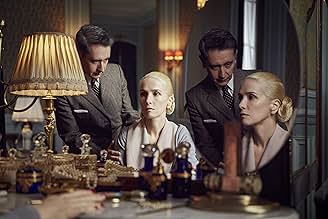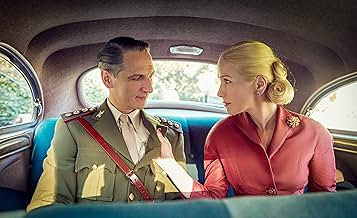IMDb-BEWERTUNG
6,8/10
1076
IHRE BEWERTUNG
Das manchmal fast surreale und immer bedeutungsvolle Schicksal von Eva Peróns Leiche nach ihrem Tod 1952, die jahrzehntelang auf ihre Bestattung wartete.Das manchmal fast surreale und immer bedeutungsvolle Schicksal von Eva Peróns Leiche nach ihrem Tod 1952, die jahrzehntelang auf ihre Bestattung wartete.Das manchmal fast surreale und immer bedeutungsvolle Schicksal von Eva Peróns Leiche nach ihrem Tod 1952, die jahrzehntelang auf ihre Bestattung wartete.
- Auszeichnungen
- 14 Gewinne & 11 Nominierungen insgesamt
Folgen durchsuchen
Empfohlene Bewertungen
Alterio, Oreiro, the music, the reconstruccion of the period, the story E V E R Y T H I N G sooo good, I recomend it sincerely. For the ones that lived these tragic days it is like coming back for a while.
Santa Evita contains all those elements that make a successful mini-series: an excellent cast, a strong and passionate story, great cinematography and direction, and a great soundtrack.
Natalia Oreiro, with a flawless performance, gives life to perhaps the best Evita Peron we have seen so far on television and cinema. The series presents a more humane and truer approach to the first lady of Argentina and it achieves its goal through the multifaceted interpretation of the protagonist, who manages to render precisely and without succumbing to imitation the changes in attitude, movements, and voice of Evita through time until the end of her life. From the rest of the performances, Ernesto Alterio stands out with a dark character interpreted as perfection.
Santa Evita is not a biography and should not be judged as such. It's an incredible, dark journey full of passion and tension that nevertheless deals with issues that are still connected with our society.
Natalia Oreiro, with a flawless performance, gives life to perhaps the best Evita Peron we have seen so far on television and cinema. The series presents a more humane and truer approach to the first lady of Argentina and it achieves its goal through the multifaceted interpretation of the protagonist, who manages to render precisely and without succumbing to imitation the changes in attitude, movements, and voice of Evita through time until the end of her life. From the rest of the performances, Ernesto Alterio stands out with a dark character interpreted as perfection.
Santa Evita is not a biography and should not be judged as such. It's an incredible, dark journey full of passion and tension that nevertheless deals with issues that are still connected with our society.
Far from being a masterpiece like other TV shows and movies produced in Argentina, Santa Evita is a nice fiction vaguely based on Eva Perón's very interesting live and the misadventures of her corpse after one of the many political turmoils in Argentina's history. The show is a great opportunity to know more about history of Argentina.
Wherever there's an Alterio's family member on screen it is worth watching the show. Besides, the rest of Argentinians do it well. Maybe the only drawback I've found is quite a lack ok likeness in settings and other stuff I haven't reckoned as hundred per cent reliable or perhaps a bit too much artificial.
Evita's very existence and all it symbolically meant is intolerable for the Argentine elite. The "Argentine hate" is an elite hate, a right-wing hate, hate with a clear and precise purpose: to block, limit, reduce and if possible exterminate (in the absolute sense of the term) the expressions of the
popular struggles. The series follows the seizure of the corpse of First Lady Argentina Eva Peron, for the people who loved her Evita, after her remains were embalmed and then exposed to the public for three years for a final farewell. Her remains, however, were stolen by the civilian-military dictatorship called "revoluciòn libertadora" and never returned nor placed in the family tomb.
It is precisely on the body of Evita / Donna that unfolds the myth that grew around it for over two decades. After a military coup in Argentina in 1955 overthrew the then president Juan Domingo Perón, Evita's corpse was hidden for 16 years to prevent it from becoming a symbol against the civic-military regime. A singular, unique, and at times surreal episode, which contributed to the creation of a further legendary aura around the figure of Evita for a woman who literally managed to go beyond her own death, in the everlasting memory of the Argentine and world people.
Anti-Peronism, the National-Catholic reactionaries, could not have Eva Perón celebrated as a saint, but all this work done for the concealment of the corpse had the opposite effect. In a non-chronological and non-linear narrative, Evita's life is told: orphaned by her father, at 15 she leaves everything and goes to Buenos Aires to try to break into the world of entertainment. She first became an actress, then a political and philanthropist, after the fortuitous meeting with the then colonel Juan Domingo Perón. The narrative moves back and forth, with pills and moments to reconstruct that fascinating and complex puzzle that was Evita's existence, as the title demonstrates, punctual and built on the body of the "b-word" as the big landowners oligarchs together with their military lackeys called her. The performers are never inclined to exasperate acting as often happens in Spanish language productions and offer some really suggestive sequences, like a scene that recalls the sanctity of the woman in the eyes of the people, given that she has always fought for their rights being also trade unionist.
It is precisely on the body of Evita / Donna that unfolds the myth that grew around it for over two decades. After a military coup in Argentina in 1955 overthrew the then president Juan Domingo Perón, Evita's corpse was hidden for 16 years to prevent it from becoming a symbol against the civic-military regime. A singular, unique, and at times surreal episode, which contributed to the creation of a further legendary aura around the figure of Evita for a woman who literally managed to go beyond her own death, in the everlasting memory of the Argentine and world people.
Anti-Peronism, the National-Catholic reactionaries, could not have Eva Perón celebrated as a saint, but all this work done for the concealment of the corpse had the opposite effect. In a non-chronological and non-linear narrative, Evita's life is told: orphaned by her father, at 15 she leaves everything and goes to Buenos Aires to try to break into the world of entertainment. She first became an actress, then a political and philanthropist, after the fortuitous meeting with the then colonel Juan Domingo Perón. The narrative moves back and forth, with pills and moments to reconstruct that fascinating and complex puzzle that was Evita's existence, as the title demonstrates, punctual and built on the body of the "b-word" as the big landowners oligarchs together with their military lackeys called her. The performers are never inclined to exasperate acting as often happens in Spanish language productions and offer some really suggestive sequences, like a scene that recalls the sanctity of the woman in the eyes of the people, given that she has always fought for their rights being also trade unionist.
Top-Auswahl
Melde dich zum Bewerten an und greife auf die Watchlist für personalisierte Empfehlungen zu.
- How many seasons does Santa Evita have?Powered by Alexa
Details
- Erscheinungsdatum
- Herkunftsland
- Sprache
- Auch bekannt als
- Santa Évita
- Drehorte
- Palacio Sans Souci, Buenos Aires, Bundesdistrikt, Argentinien(presidential residence)
- Produktionsfirmen
- Weitere beteiligte Unternehmen bei IMDbPro anzeigen
Zu dieser Seite beitragen
Bearbeitung vorschlagen oder fehlenden Inhalt hinzufügen

































